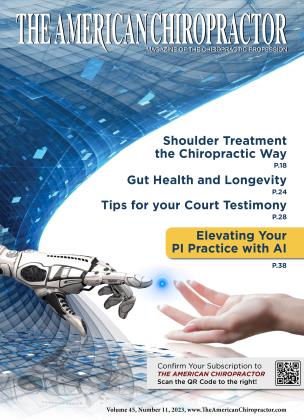Harnessing Intensity in Sports
IN BRIEF
SPORTS CHIROPRACTIC
The Mental Facet and the Role of Gamma Sensory Stimulation
Joseph Ventura
DC
Intensity is the powerhouse behind every sports spectacle, pushing athletes to reach extraordinary feats and deliver those heart-stopping moments that define sports history. However, the depth of intensity transcends physicality because it is a wholly mental phenomenon. It demands surpassing one’s thresholds, shattering limitations, and reaching for the unprecedented.
As potent as it is, intensity also possesses the potential to derail athletes from their path to success. This raises a crucial question: How can one wield the power of intensity without succumbing to its pitfalls? Emerging research points to a revolutionary answer — gamma sensory stimulation. Intensity is irrefutably mental; it is the mindset that allows athletes to confr ont their physical and psychological boundaries fearlessly. As Gross et al. (2018) articulate in their research, athletes’ mental state plays a significant role in their performance. Their study on the mental toughness of athletes underscores intensity as a mental phenomenon, reinforcing the concept that psychological elements can drive sports performance.
Intensity can be a double-edged sword. One side fuels greatness — focus, dedication, and commitment — while the other takes risks, leading to overtraining, burnout, and injury (Kellmann, 2010). The duality of intensity necessitates athletes to strike a delicate balance between harnessing its power and avoiding its perils.
Gamma sensory stimulation is a promising tool emerging in the field of neuroscience to help navigate this challenge. This technique involves stimulating the brain’s gamma waves (40Hz), which has been shown to positively impact higher mental activities, including perception, problem-solving, and consciousness (Lebedev et al., 2018). By influencing these critical facets of the mind, athletes can gain better control over their mental intensity, channeling it for enhanced performance outcomes and mitigating the adverse effects.
Innovative applications of gamma sensory stimulation technology offer athletes a mechanism to harness then mental state, regulate their intensity, and optimize their performance. A notable study conducted by Hashemi et al. (2016) demonstrated that gamma brain wave stimulation could improve cognitive functions, potentially enhancing athletic performance.
Incorporating gamma sensory stimulation into athletic routines can transform the nature of intensity from being a wild, uncontrollable force to a finely tuned instrument of performance enhancement. By har nessing the power of intensity, athletes can drive their performance to new levels, achieve then sporting goals, and reduce the risk of burnout and injuries.
In conclusion, while intensity in sports is a double-edged sword, a balanced approach, supported by resear ch and the use of innovative techniques such as gamma sensory stimulation, can help athletes wield this power effectively. As scientific advancements continue to unfold, the future of intensity in sports looks promising, paving the way for a new era of athletic performance.
Dr. Joseph Ventura is the innovative founder of AXION Gamma Centers of America. His breadth of expertise spans authorship, invention, artistry, and public speaking. Ventura’s significant contributions include coauthoring insightful books on stress management in youth sports and enhancing sports performance. He can be reached at [email protected] and byphone913-239-8465. Visit gammacenters.com.
References
1. Gross, J.J., et al. (2018). The power of mental intensity in sports. Journal of Applied Sport Psychology. 30(3), 347-361.
2. Kellmann M. (2010). Preventing overtraining in athletes in high-intensity sports and stress/recovery monitoring. Scandinavian Journal of Medicine & Science in Sports, 20 Suppl 2, 95-102. https://doi.org/10.llll/ i.l600-0838.2010.01192.x
3. Lebedev, A.V., et al. (2018). Rhythms of the brain: An examination of mixed mode oscillation approaches to the analy sis of neurophysiological data. Chaos, 2#(10), 106309.
4. Hashemi, A., et al. (2016). The study of brain waves and functional connectivity associated with neurofeedback training in children with ADHD. Basic and Clinical Neuroscience, 7(3), 193-202.
 View Full Issue
View Full Issue









